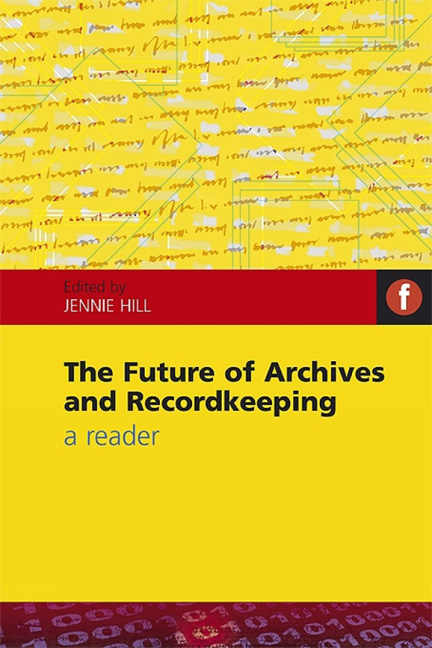Book contents
- Frontmatter
- Dedication
- Contents
- Acknowledgements
- Contributors
- Introduction: seeing the future of archives and recordkeeping
- Part 1 Defining archives
- Part 2 Shaping a discipline
- 4 Structural and formal analysis: the contribution of diplomatics to archival appraisal in the digital environment
- 5 Archivistics: science or art?
- Part 3 Archive 20: archives in society
- Part 4 Archives in the information age: is there still a role for the archivist?
- Index
- Miscellaneous Endmatter
- Miscellaneous Endmatter
- Miscellaneous Endmatter
4 - Structural and formal analysis: the contribution of diplomatics to archival appraisal in the digital environment
from Part 2 - Shaping a discipline
Published online by Cambridge University Press: 08 June 2018
- Frontmatter
- Dedication
- Contents
- Acknowledgements
- Contributors
- Introduction: seeing the future of archives and recordkeeping
- Part 1 Defining archives
- Part 2 Shaping a discipline
- 4 Structural and formal analysis: the contribution of diplomatics to archival appraisal in the digital environment
- 5 Archivistics: science or art?
- Part 3 Archive 20: archives in society
- Part 4 Archives in the information age: is there still a role for the archivist?
- Index
- Miscellaneous Endmatter
- Miscellaneous Endmatter
- Miscellaneous Endmatter
Summary
Introduction
‘Analysis is the essence of archival appraisal’ (Schellenberg, 1956a, 45 [277]). All those who have written about appraisal, regardless of their perspective, beliefs and context, agree that the key to the accurate assessment of the value of records is a systematic and rigorous analysis of their context, interrelationships, form, content and/or use. They may disagree on the methodology for, or on the object of, analysis but, since the mid-19th century, the idea that appraisal could be based on intuition has all but disappeared, being replaced by the conviction that appraisal can only result from a scientific process of analysis, regardless of the interest being served and the criteria being followed.
Structural analysis
Structural analysis was introduced in the discourse on appraisal in the 20th century by German theorists. Although many archivists in Germany still supported the primacy of content analysis aimed at determining the usefulness of records for future historical research (Zimmerman, 1959), structural analysis began to dominate appraisal methodology, mostly as a consequence of the widespread inter national acceptance of the principle of provenance as the theoretical basis of archival arrangement. If meaning is derived from context, then an understanding of the administrative structure of a records’ creator should be able to guide not simply arrangement, but also appraisal (Heredia Herrera, 1987, 123). To German archivists, the destruction of copies and transitory records was still the proper thing to do, because they were extraneous to the understanding of context and structure (Doehaerd, 1950, 325), until, in 1939, Hans O. Meissner re-issued and developed the systematic appraisal standards formulated in 1901 by Georg Hille. His primary contribution to appraisal methodology was the use of structural analysis to gather an understanding of the organization, functions and activities of the records-creating body. However, he believed that such analysis had to be combined with that of subject content in order to be able to identify records of value (Klumpenhouer, 1988, 52). In 1940, Hermann Meinert endorsed Meissner's standards arguing though that the value of records depends primarily on the significance of a records’ creator within an administrative hierarchy, which can be determined through an analysis of its position in such a structure, of the nature of its activities, and of their relationship with those of superior and subordinate administrative units (Schellenberg, 1956b, 137).
- Type
- Chapter
- Information
- The Future of Archives and RecordkeepingA reader, pp. 69 - 92Publisher: FacetPrint publication year: 2010

